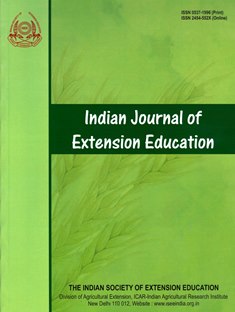Climate Resilient Farming: Influence of Livelihood Assets on Agrochemical vs Organic Input Use in Coastal India
DOI:
https://doi.org/10.48165/IJEE.2025.61420Keywords:
Agrochemical intensification, Climate change, Livelihood assets, Organic farming, Sustainability.Abstract
Climate change poses immense pressure on global agriculture, particularly in coastal regions. Several adaptation strategies to climate change were taken by farmers, though not all are aligned with long-term sustainability. Through logistic regression, the study assesses the role of livelihood assets in farmers’ choices between agrochemical intensification and organic farming, where livelihood assets were measured using the Department for International Development’s (DFID) framework. The study covered five coastal states and one coastal union territory of India. Using a stratified random sampling method, 520 agricultural households were surveyed during 2024–2025. Villages were selected based on proximity to the sea and the implementation of the National Innovation on Climate Resilient Agriculture (NICRA) and Project on Climate Resilient Agriculture (PoCRA) programmes. Findings indicate physical capital as a pivotal factor encouraging organic farming and curbing agrochemical intensification, while human capital reduces reliance on agrochemicals. Natural and financial capital enhance agrochemical use. The dual positive influence of social capital on organic farming and agrochemical intensification underscores the need for tailored guidance, as affirmed by sustainability-oriented initiatives, proven effective in limiting agrochemical intensification as NICRA and PoCRA. Inclusion in such programmes and enhancing human and physical capital may reinforce farmers’ orientation with sustainable adaptation trajectories.
Downloads
References
Chen, Y., Xiang, W., & Zhao, M. (2024). Impacts of capital endowment on farmers’ choices in fertilizer-reduction and efficiency-increasing technologies (Preferences, Influences, and Mechanisms): A case study of apple farmers in the provinces of Shaanxi and Gansu, China. Agriculture, 14(1), 147. https://doi.org/10.3390/agriculture14010147
Combary, O. S. (2022). Farm productivity under financial constraints in developing countries: Evidence from maize smallholder farmers in Burkina Faso. Agricultural and Resource Economics Review, 51(2), 380–390. https://doi.org/10.1017/age.2022.8
Das, U., Ansari, M. A., & Ghosh, S. (2024). Measures of livelihoods and their effect on vulnerability of farmers to climate change: Evidence from coastal and non-coastal regions in India. Environment, Development and Sustainability, 26, 4801–4836. https://doi.org/10.1007/s10668-023-02911-z
Das, U., Ansari, M. A., Ghosh, S., Patnaik, N. M., & Maji, S. (2025). Determinants of farm household resilience and its impact on climate-smart agriculture performance: Insights from coastal and non-coastal ecosystems in Odisha, India. Agricultural Systems, 227, 104370. https://doi.org/10.1016/j.agsy.2025.104370
Das, U., Ghosh, S., & Mondal, B. (2020). Resilience of agriculture in a climatically vulnerable state of India. Theoretical and Applied Climatology, 139, 1513–1529. https://doi.org/10.1007/s00704-019-03061-x
Dasgupta, S., Wheeler, D., Sobhan, M. I., Bandyopadhyay, S., Nishat, A., & Paul, T. (2020). Coping with climate change in the Sundarbans: Lessons from multidisciplinary studies. International Development in Focus. Washington, DC: World Bank. https://doi.org/10.1596/978-1-4648-1587-4
De, D., & Das, C. S. (2021). Measuring livelihood sustainability by PCA in Indian Sundarban. Environment, Development and Sustainability, 23, 18424–18442. https://doi.org/10.1007s10668-021-01451-8
FAO. (2021). The impact of disasters and crises on agriculture and food security: 2021. Food and Agriculture Organization of the United Nations. Rome. https://doi.org/10.4060/cb3673en
Gopalakrishnan, T., Hasan, M., Haque, A., Jayasinghe, S., & Kumar, L. (2019). Sustainability of coastal agriculture under climate change. Sustainability, 11(24), 7200. https://doi.org/10.3390/su11247200
Guo, J., & Chen, J. (2022). The impact of heavy rainfall variability on fertilizer application rates: Evidence from maize farmers in China. International Journal of Environmental Research and Public Health, 19(23), 15906. https://doi.org/10.3390/ijerph192315906
Hu, Z. (2020). What socio-economic and political factors lead to global pesticide dependence? A critical review from a social science perspective. International Journal of Environmental Research and Public Health, 17(21), 8119. https://doi.org/10.3390/ijerph17218119
Karki, L., Schleenbecker, R., & Hamm, U. (2012). Factors influencing a conversion to organic farming in Nepalese tea farms. Journal of Agriculture and Rural Development in the Tropics and Subtropics, 112(2), 113–123.
Ma, Q., Zheng, S., & Deng, P. (2022). Impact of internet use on farmers’ organic fertilizer application behavior under the climate change context: The role of social network. Land, 11(9), 1601. https://doi.org/10.3390/land11091601
Maksimovich, K. Y., Lisitsin, A. E., Aleschenko, V. V., Yakushev, M. A., & Sayfutdinova, M. A. (2023). Rural area infrastructure as a factor in the development of organic farming. E3S Web of Conferences, 443, 04003. https://doi.org/10.1051/e3sconf/202344304003
Malhotra, L. (2017). India - Maharashtra Project on Climate Resilient Agriculture: Environmental assessment – Environment management framework (Report No. SFG3745). World Bank. https://documents.worldbank.org/en/publication/documents-reports/documentdetail/638511509432683183
Ministry of Agriculture and Farmers Welfare. (2025, February 7). Initiatives to promote sustainable farming practices and resilience against climate change. Press Information Bureau, Ministry of Agriculture & Farmers Welfare, Government of India. https://pib.gov.in/PressReleasePage.aspx?PRID=2100674
Mishra, A. K., Deep, S., & Choudhary, A. (2015). Identification of suitable sites for organic farming using AHP & GIS. The Egyptian Journal of Remote Sensing and Space Science, 18(2), 181–193. https://doi.org/10.1016/j.ejrs.2015.06.005
Murry, N. (2019). SWOT analysis of organic farming with special reference to Nagaland. Agricultural Reviews, 40(3), 243–246. https://doi.org/10.18805/ag.D-4974
Namgyal, P., Sarkar, S., & Kumar, R. (2025). Vulnerability assessment of rural households to climate change using livelihood vulnerability framework approach in the trans-Himalayan region of Ladakh, India. Anthropocene, 49, 100467. https://doi.org/10.1016/j.ancene.2025.100467
Pelinson, R. M., Valente, B. R. S., Shimabukuro, E. M., & Schiesari, L. (2023). Impacts of agrochemical intensification and spatial isolation on the assembly and reassembly of temporary pond metacommunities. Journal of Applied Ecology, 60(10), 2235–2250. https://doi.org/10.1111/1365-2664.14480
Pradhan, S. K., Naik, A., Kumar, A., & Ray, S. (2025). Perception of paddy farmers on climate change in western Odisha: An ANN model integration. Indian Journal of Extension Education, 61(3), 1–6. https://doi.org/10.48165/ijee.2025.61301
Quan, Q., Yi, F., & Liu, H. (2024). Fertilizer response to climate change: Evidence from corn production in China. Science of The Total Environment, 928, 172226. https://doi.org/10.1016/j.scitotenv.2024.172226
Ren, J., Lei, H., & Ren, H. (2022). Livelihood capital, ecological cognition, and farmers’ green production behavior. Sustainability, 14(24), 16671. https://doi.org/10.3390/su142416671
Ren, Z., & Jiang, H. (2022). Risk cognition, agricultural cooperatives training, and farmers’ pesticide overuse: Evidence from Shandong Province, China. Frontiers in Public Health, 10. https://doi.org/10.3389/fpubh.2022.1032862
Sahu, R. S., & Tiwari, M. (2024). Ensuring sustainable livelihoods and inclusive growth of Indian smallholder farmers through organic farming: A systematic literature review. Socio-Ecological Practice Research, 6(3), 229–243. https://doi.org/10.1007/s42532-024-00190-0
Sharma, P., Riar, T. S., & Garg, L. (2020). Buying behavior and farmers’ practices regarding agrochemicals use on rice crop in Punjab. Indian Journal of Extension Education, 54(4), 87–91.
Sibarani, R. W., & Somboonsuke, B. (2024). Analysis of the level of livelihood assets ownership of farmers in conventional and organic paddy farming in two adjoining villages. Journal of Sustainability Science and Management, 19(1), 96–112. https://doi.org/10.46754/jssm.2024.01.009
Siegert, M., Alley, R. B., Rignot, E., Englander, J., & Corell, R. (2020). Twenty-first-century sea-level rise could exceed IPCC projections for strong-warming futures. One Earth, 3(6), 691–703. https://doi.org/10.1016/j.oneear.2020.11.002
Xie, L., Qiu, Z., You, L., & Kang, Y. (2020). A macro perspective on the relationship between farm size and agrochemicals use in China. Sustainability, 12(21), 9299. https://doi.org/10.3390/su12219299
Yadav, P., Meena, B. S., Kumar Saurav, S.,Pavan, P., Barman, B., Anu, J., & Bishnoi, S. (2025). Effectiveness of climate resilient interventions on performance of dairy animals in Karnal district of Haryana. Indian Journal of Extension Education, 61(3), 52–57. https://doi.org/10.48165/ijee.2025.61310
Yang, J., & Cui, X. (2025). How livelihood capital affects farmers’ green production behavior: Analysis of mediating effects based on farmers’ cognition. Sustainability, 17(2), 763. https://doi.org/10.3390/su17020763
Yuan, X., Li, S., Chen, J., Yu, H., Yang, T., Wang, C., Huang, S., Chen, H., & Ao, X. (2024). Impacts of global climate chane on agricultural production: A comprehensive review. Agronomy, 14(7), 1360. https://doi.org/10.3390/agronomy14071360
Zhang, H., Ma, W., & Sang, X. (2025). Credit access and sustainable farm investments: A dual perspective on chemical and environmentally friendly inputs. International Journal of Sustainable Development & World Ecology, 32(4), 485–497. https://doi.org/10.1080/13504509.2025.2488042
Downloads
Published
Issue
Section
License

This work is licensed under a Creative Commons Attribution-NonCommercial-NoDerivatives 4.0 International License.

